THE MILL
Newsletter for Members and Friends of High Salvington Windmill September 2022
The image on the right shows the mill sweeps set to mourning position.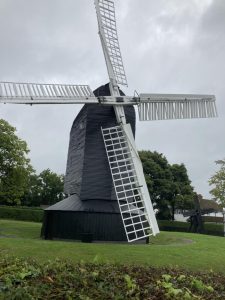 This was done to mark the death of HM Queen Elizabeth II. The tradition dates from earlier times when mill sweeps were used to announce more local births and deaths.
This was done to mark the death of HM Queen Elizabeth II. The tradition dates from earlier times when mill sweeps were used to announce more local births and deaths.
This season, with the aim of addressing our need for new millers, Bob Potts and Hazel Marsden have been running a series of training sessions. We hope to have several new millers fully trained by the end of the 2023 season. Our former wheat supplier has stopped selling grain in the small quantities we and many other mills require. While Sussex Mills Group is addressing this issue on behalf of many of its members, we were fortunate that Barry Flannaghan at Burton Watermill, who had obtained grain from a farmer in Petworth and developed his own grain-cleaning equipment, donated 55Kg to us for miller training.
After the enforced closures of 2020 and limited opening in 2021, 2022 started well, with a very successful public meeting during which many our existing volunteers were on hand to talk about our requirements. Dave Porter’s film, “Restoration of High Salvington Windmill”, featuring Peter Casebow, was shown. From the meeting itself and calls before and afterwards, over 50 new volunteers came forward, all of whom have made a valuable contribution to helping maintain the mill, run open days and events.
In June, to celebrate the Queen’s Platinum Jubilee, the High Salvington Residents’ Association and the Mill Trust joined forces to host a picnic on the mill field. This was widely enjoyed, so it is likely that this will become an annual event and plans for 2023 are already in progress! Keep an eye on your Residents’ Association newsletter for details.
Our open days and events have gone very well this year, some with record numbers in attendance. Our thanks to the new team of Phil Dawson, Paul Kuhn, Julie Gaskell and Sam Bisset, who joined us in January and pulled out all the stops to deliver a very successful fete.
Cereal products: the early medieval period to now
The importance of bread in the early medieval period is highlighted by the Old English words for lord (hlaford) and lady (hloefdige), meaning loaf keeper and loaf kneader respectively. Payments and rents were often made in loaves. As in Roman times bread from fine white flour was considered the best and on feast days spiced bread or cakes were made. Bread was considered a strengthening food and medical books contained recipes using fine flour for those patients with delicate stomachs. There seem to have been two basic sizes of loaf, large and small. Bread was usually eaten with butter or dripping or something more substantial such as cheese, beans or meat.
The story of King Alfred burning the cakes is well known and although it is only a tale written to illustrate his desperate plight after his defeat by the Danes at Chippenham in AD878, it nevertheless illustrates that in many households bread would have continued to be baked on the hearth. However, ovens are also known, mostly associated with monastic and wealthier establishments such as at North Elmham in Norfolk, Goltho in Lincolnshire and Portchester, Hampshire.
Bread continued to be a staple food throughout the Middle Ages. In rural areas, most households baked their own bread. This was probably usually under a pot on a hearthstone but some small rural cottages, such those excavated at Hangleton on the Sussex Downs and Tresmorn in north Cornwall, had their own ovens. The floor of the oven in the cottage at Tresmorn was a granite rotary quernstone – a not uncommon reuse. Monasteries, castles and manor houses also had their own bakehouses and ovens. . You can read the rest of this article at The Mills Archive ( Chapter 14 From Quern to Computer).
Craft Fair
Over twenty-five stallholders had a splendid afternoon displaying their home-crafted product. The public arrived to browse the stalls. A coach party from Maidstone also arrived, with the coach parking outside the shop for a couple of hours. Thanks to Andy Campbell for organising the event.
| Card Payments
We started taking credit/debit card payments at the gate and in the tea-room in 2021. The pandemic seems to have accelerated a cashless society, and we were surprised by how many people now turn up without a single penny in their pockets. The app proved to be easy to use, and several of us have now trained in its use. Cashless payment does not extend to individual stalls at the fete. However, you will be able to purchase bags of cash with a card. Craft stall holders often have their own system. If you prefer to pay your membership dues by card, please go to our website. You can also pay your membership at the gate. Or fill in the form on page 5 and post to our membership secretary.
|
| From the Treasurer
This has been a very successful season with most open days being well supported. The fete was particularly spectacular with over 1000 paying visitors and takings on the day of £5800 before expenses. The Classic Car Day in August and the Craft Fair in September also generated lots of interest and takings for each were over £1300. I changed our electricity supplier in April and fixed the tariff for 3 years so, although now at a slightly higher rate, we are at least protected from further rises for a while. The Village Shop has been holding a Sunday charity collection in exchange for nibbles and have twice given these proceeds to the Mill. We thank them and wish them success in their new venture.
|
The mystery of windmill remains found in some barrows in Sussex: Bronze Age burial mounds later reused as windmill-steads. By Alex Vincent
Bronze Age barrows come in several types and shapes, including platform, saucer, bell, disc and bowl – the most common type. They were as much as two to three metres in height. They were used as burial chambers and were either a single burial or for several people. Some held cremated remains which were placed in an urn and covered in earth. Barrows exist today as grassy earthen mounds, but were once bare chalk, which showed up clearly as monuments to people below the hills. A great number have been ploughed out over the years. Several Bronze Age barrows were reused as mill mounds or windmill-steads – mainly in the medieval period.
| 2An ancient barrow at Rookery Hill |
In the 18th and 19th centuries, during excavations of some barrows, stone foundations and timber structure remains of post mills were found. These were not identified as mill remains until the early 20th century. Charles Monkman was one of the first to discuss some of these cruciform structures found in East Yorkshire. Studies were made of some 10,000 barrows during the 20th century and some were identified as having been reused as a windmill-stead.
A medieval windmill was smaller than the later ones and for this reason the posts were sunken for extra stability. A mound, called a mill ball, would have been built around it and as most barrows were round in shape, they were ideal to use as a mill base. These windmills would have been open trestle post mills.
Several barrows in Sussex later became bases for windmills. Examples are at The Mill Ball Houghton, The Trundle at Singleton, Summer Hill, Newtimber, Piddinghoe, Glynde, Firle Beacon, Willingdon Hill and Rookery Hill Bishopstone. In the case of the latter, it is said to be one of the earliest windmills recorded in Sussex.
There could be other old windmill sites, which used Bronze Age barrows as their bases. One example could be the 16th century windmill at Highdown. The mound it stood on looks as if it was once a barrow. The medieval windmills recorded on Highdown may be on the site of the later 16th century mill.
ooOoo
Books
This year the book stall has made around £280 at the various open days. Thank you to everyone who has donated books in the past. However, we no longer take DVDs/ CDs or hardback books as donations for the Windmill Book stall. These items do not sell very well and are cumbersome to move around. Paperback novels and children’s books are always welcome and sell well. You can contact me by calling 01903 695219. I’m happy to collect. Angela McMillan
The hay rake in the granary
Have you ever looked at the replica hay rake? It was made by millwright Bob Potts to a design which he had seen in use in France.
In the 1980s the grass was cut once a year on the mill site. It was then turned to dry, using this hay rake, before storing. Thus, it became hay which was then used by local ponies and goats etc. Of course, the grass needed cutting more than once a year. So, sheep were used to graze the site and keep the grass down.
The sheep were a Welsh mountain cross. They were forever getting out and the volunteers would often get a call late at night from an annoyed neighbour and had to go out looking for the sheep.
Bob Potts and Pete Casebow tried their hand at shearing the sheep. It took them two hours to shear one! They found shears were useless and used scissors. Not surprisingly it was decided that it was better to mow the grass regularly, as is done today.
ooOoo
Refreshments
As a result of a very successful volunteers recruitment evening in January there were many new helpers for serving teas and baking cakes (a special mention to Gill Johnson who kindly donated the many cakes she made). All the helpers said how much they enjoyed themselves when it was their turn to man the tea bar.
We have had some exceptionally busy open Days where we have literally run out of cakes and ice creams!
An interesting fact…. for the last three Open Days…the Car Day, the Scalextric and the Autumn Craft Fair, a slice of cake was sold for every minute the Mill was open! Now that’s an awful lot of cake!!
A huge thank you from me to all the volunteers who helped with the refreshments. Mel Wickett
Private Mill Bookings and tours 2022
This was my first year arranging the private bookings at the windmill. The mill tours have been very popular this year, especially with young groups such as Beavers, Scouts and Childminders. Two groups of adults – Worthing Renaissance WI and Arun Art Group – also visited. Vale School had an enjoyable morning at the mill earlier this month. The shop is very popular with the younger groups – especially the toy windmills. The childminders loved the cakes and refreshments. Everyone who visited seemed to enjoy themselves. Apart from the excitement of seeing the mill the children just love rolling down the mound and cartwheeling across the grass. Flour being ground before their eyes and having a go at doing it themselves was very exciting and the water pump intrigued them.
Everyone has been so kind and encouraging for this my first year of taking bookings. Angela Stephens
ooOoo
| Talks to groups. In the past few weeks, Lucy has given a talk on our mill and how it was restored to local groups. If you would like a talk for your group, please get in touch at the address below. |
‘The Mill’ is edited by Lucy Brooks. 01903 691945. lucindafbrooks@outlook.com

 We took advantage of 2020’s downtime to completely repaint the mill buck, roundhouse and sweeps and the maintenance team has been in regular attendance keeping the grounds maintained and repainting the other buildings.
We took advantage of 2020’s downtime to completely repaint the mill buck, roundhouse and sweeps and the maintenance team has been in regular attendance keeping the grounds maintained and repainting the other buildings.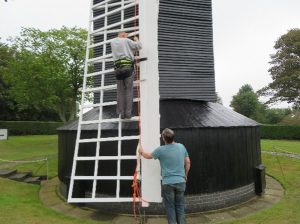 On 26th September, the maintenance team took down the sail cloths. Peter Casebow and Hazel Marsden took the opportunity to carry out a training session to introduce the new sail climbing safety system. Peter started with how to tie the reef knots to safely attach the safety rope to the fencing pins. After this, Adam, Greg and Matt were introduced to the new method for safely climbing the sails. This involves tying a climbing rope around the whip of one sweep, before rotating the sweeps 180° to tie off the other end around the opposing whip. A separate loop of cord is then looped around the rope in a “Prusik Loop”, A carabiner is attached to a safety harness that the sail climber wears which they use to attach to the prusik loop. Should they fall off the sweep they are climbing, the prusik loop will tighten and prevent a long fall. The canvas sail cloths were duly removed in the safest manner employed to date and spread out in the round house to dry off before being stowed away for the winter.
On 26th September, the maintenance team took down the sail cloths. Peter Casebow and Hazel Marsden took the opportunity to carry out a training session to introduce the new sail climbing safety system. Peter started with how to tie the reef knots to safely attach the safety rope to the fencing pins. After this, Adam, Greg and Matt were introduced to the new method for safely climbing the sails. This involves tying a climbing rope around the whip of one sweep, before rotating the sweeps 180° to tie off the other end around the opposing whip. A separate loop of cord is then looped around the rope in a “Prusik Loop”, A carabiner is attached to a safety harness that the sail climber wears which they use to attach to the prusik loop. Should they fall off the sweep they are climbing, the prusik loop will tighten and prevent a long fall. The canvas sail cloths were duly removed in the safest manner employed to date and spread out in the round house to dry off before being stowed away for the winter. On 10th October, a small group of maintenance volunteers prepared the wind and village pumps for the winter. Water reservoirs were emptied, using a small, portable electric pump. Then, pumps were partly dismantled to remove water inside them before everything was reassembled. The village pump and Nutley wind engine both have additional valves to keep water in the pipes under normal operations so that they will commence delivering water immediately upon operation. The Glynde wind pump lacks this feature, which is why this machine always takes longer to start pumping water once the sails start to turn.
On 10th October, a small group of maintenance volunteers prepared the wind and village pumps for the winter. Water reservoirs were emptied, using a small, portable electric pump. Then, pumps were partly dismantled to remove water inside them before everything was reassembled. The village pump and Nutley wind engine both have additional valves to keep water in the pipes under normal operations so that they will commence delivering water immediately upon operation. The Glynde wind pump lacks this feature, which is why this machine always takes longer to start pumping water once the sails start to turn.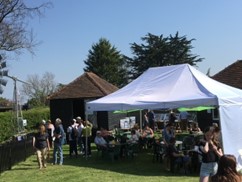 The Board decided to honour the founder members of the Trust at a special Saturday afternoon opening during the
The Board decided to honour the founder members of the Trust at a special Saturday afternoon opening during the  The annual Craft Fair is quite a different event these days from its origins many years ago. Initially it was started to encourage the use of traditional rural skills such as hedge laying and wood turning. Over the years it has changed as more and more crafters and other people who enjoy traditional skills such as jam making, mosaics and the like asked to become involved. In its modern guise the Craft Fair can have as many as thirty plus stalls ranging from the “Jam Lady” and the “cheese man” to pyrography (yes, writing with fire – also known as poker work), a good variety of craft exhibitors, mosaics, jewellery, handmade toys and cakes. We also still have some of the exhibitors who retain our links with the fair’s origins in the walking stick man (who also does a great line in Harry Potter type wands) and the traditional pole lathe, turning wood without any machinery. And our friends from Sompting Morris Dancers come and perform during the afternoon.
The annual Craft Fair is quite a different event these days from its origins many years ago. Initially it was started to encourage the use of traditional rural skills such as hedge laying and wood turning. Over the years it has changed as more and more crafters and other people who enjoy traditional skills such as jam making, mosaics and the like asked to become involved. In its modern guise the Craft Fair can have as many as thirty plus stalls ranging from the “Jam Lady” and the “cheese man” to pyrography (yes, writing with fire – also known as poker work), a good variety of craft exhibitors, mosaics, jewellery, handmade toys and cakes. We also still have some of the exhibitors who retain our links with the fair’s origins in the walking stick man (who also does a great line in Harry Potter type wands) and the traditional pole lathe, turning wood without any machinery. And our friends from Sompting Morris Dancers come and perform during the afternoon. Thanks to Peter Hine for this image.
Thanks to Peter Hine for this image.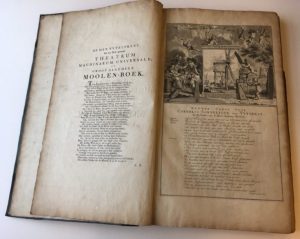 In our special collections here at the Mills Archive, we have an original copy of the Theatrum Machinarum Universale of Groot Algemeen Moolen-Boek, which translates as the Universal Theatre of Machines or Large General Mills Book, produced by Johannis van Zyl and Jan Schenk in 1734, and republished in 1761.
In our special collections here at the Mills Archive, we have an original copy of the Theatrum Machinarum Universale of Groot Algemeen Moolen-Boek, which translates as the Universal Theatre of Machines or Large General Mills Book, produced by Johannis van Zyl and Jan Schenk in 1734, and republished in 1761. 1 Stock image – not necessarily on sale
1 Stock image – not necessarily on sale
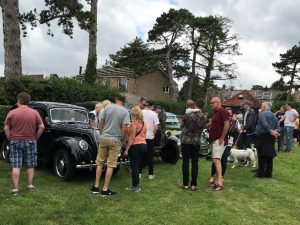
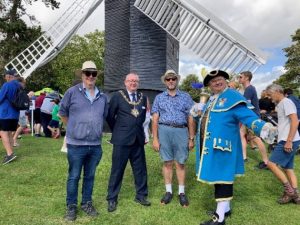
 at the end and several shops had one in their yard. Some were in back gardens or in homes. As well as obtaining water from streams, ponds, and wells, this was the only way, which people used to get their water before mains came. Pumps were used in farms and for cattle and horses along old trackways. They had a trough below them. The main reasons for the decline in use of village pumps were the cholera epidemics of the 1850s. The most famous case was the Broad Street pump in Soho, London. A cholera epidemic occurred in Soho in 1854 and the pump in Broad Street (now Broadwick Street) was taken out of action. Dr John Snow took the handle off the pump – an action that halted the cholera. A replica pump stands on the site outside the John Snow pub. There is an information board in the pub.
at the end and several shops had one in their yard. Some were in back gardens or in homes. As well as obtaining water from streams, ponds, and wells, this was the only way, which people used to get their water before mains came. Pumps were used in farms and for cattle and horses along old trackways. They had a trough below them. The main reasons for the decline in use of village pumps were the cholera epidemics of the 1850s. The most famous case was the Broad Street pump in Soho, London. A cholera epidemic occurred in Soho in 1854 and the pump in Broad Street (now Broadwick Street) was taken out of action. Dr John Snow took the handle off the pump – an action that halted the cholera. A replica pump stands on the site outside the John Snow pub. There is an information board in the pub. Members of the Fleet Air Arm
Members of the Fleet Air Arm

 from woollen toys to wooden boxes. Visitors arrived throughout the afternoon. A huge thank you to Andy Campbell who organised the event, and to all the volunteers to helped make it a success.
from woollen toys to wooden boxes. Visitors arrived throughout the afternoon. A huge thank you to Andy Campbell who organised the event, and to all the volunteers to helped make it a success.
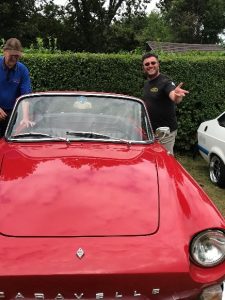 extended the scheme into July, for two further Sundays and with even more groups allowed – all distanced throughout the field, and all wearing masks when inside the mill. The results were good, and by this time we were showing people round the mill in very small family parties. However, one Sunday was affected by rain, and another by “pinging”. The no-shows were made up by passers-by asking to come in even though they hadn’t booked. It all worked out in the end, and all the volunteers on duty were thrilled to see the field busy again. We dropped the booking system for our first major event – the classic car day where we welcomed visitors in their hundreds. The picture shows one very happy exhibitor. Lucy Brooks, Board member
extended the scheme into July, for two further Sundays and with even more groups allowed – all distanced throughout the field, and all wearing masks when inside the mill. The results were good, and by this time we were showing people round the mill in very small family parties. However, one Sunday was affected by rain, and another by “pinging”. The no-shows were made up by passers-by asking to come in even though they hadn’t booked. It all worked out in the end, and all the volunteers on duty were thrilled to see the field busy again. We dropped the booking system for our first major event – the classic car day where we welcomed visitors in their hundreds. The picture shows one very happy exhibitor. Lucy Brooks, Board member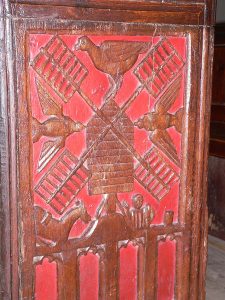 The earliest written references which specifically mention windmills date from the 1180s. In a well-documented case of 1191 Abbot Samson of Bury St Edmunds ordered the destruction of a windmill which had been built on glebe land without his permission by Herbert the dean. By the early 14th century windmills had also appeared in the north-west, at Upton-in-Widnes, Lancashire and Haulton, Cheshire, for example. While it has been suggested that windmills were built by manorial lords to supplement rather than supplant watermills, in some areas where the water supply was intermittent or the topography less favourable to providing a good fall of water, windmills became a common sight in the late medieval landscape.
The earliest written references which specifically mention windmills date from the 1180s. In a well-documented case of 1191 Abbot Samson of Bury St Edmunds ordered the destruction of a windmill which had been built on glebe land without his permission by Herbert the dean. By the early 14th century windmills had also appeared in the north-west, at Upton-in-Widnes, Lancashire and Haulton, Cheshire, for example. While it has been suggested that windmills were built by manorial lords to supplement rather than supplant watermills, in some areas where the water supply was intermittent or the topography less favourable to providing a good fall of water, windmills became a common sight in the late medieval landscape.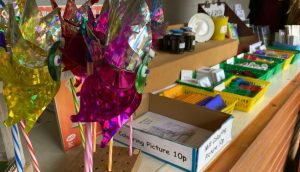

 Posting pictures of the buck cladding repairs onto our Facebook page elicited a response from an enthusiast involved in repairing mills elsewhere. Why, he wanted to know, were we replacing with lengths of board shorter than the length of the buck, leading to end-on-end joins which might be more vulnerable to rot?
Posting pictures of the buck cladding repairs onto our Facebook page elicited a response from an enthusiast involved in repairing mills elsewhere. Why, he wanted to know, were we replacing with lengths of board shorter than the length of the buck, leading to end-on-end joins which might be more vulnerable to rot?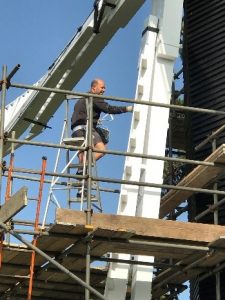 The painting of the mill by our contractor (Colin Brooker from Littlehampton) and the buck roof repairs carried out by volunteers have been completed and by the time you receive this newsletter, the scaffolding should have been removed, allowing the grand old lady to be displayed in all her glory. I’m sure autumn weather conditions will enable us to give her a quick spin too.
The painting of the mill by our contractor (Colin Brooker from Littlehampton) and the buck roof repairs carried out by volunteers have been completed and by the time you receive this newsletter, the scaffolding should have been removed, allowing the grand old lady to be displayed in all her glory. I’m sure autumn weather conditions will enable us to give her a quick spin too.

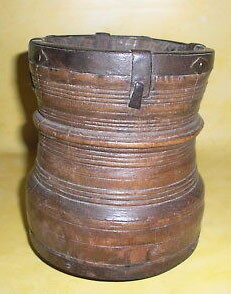


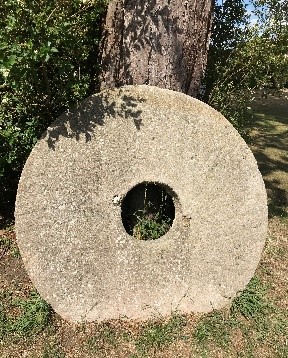
 Welcome to a special extra newsletter published by the High Salvington Windmill. As you know, the windmill has been closed all season. But we have taken advantage of this to carry out some essential maintenance work. We were fortunate to receive a Covid-19 business grant from the Government, and the Board decided to spend it to get some jobs done, and also to help the local economy by giving work to local businesses. It was necessary to hire a firm to paint the buck and the sails, while our stalwart band of volunteers will take care of the outbuildings, We thank them for so willingly giving up their time to paint and maintain these buildings. Our Chairman reports later in this newsletter on the measures the Board needs to consider for the long-term future of the windmill. We are specifically looking for a chief engineer with the right skills and experience to maintain the mill in its pristine condition, as well as a coordinator of works.
Welcome to a special extra newsletter published by the High Salvington Windmill. As you know, the windmill has been closed all season. But we have taken advantage of this to carry out some essential maintenance work. We were fortunate to receive a Covid-19 business grant from the Government, and the Board decided to spend it to get some jobs done, and also to help the local economy by giving work to local businesses. It was necessary to hire a firm to paint the buck and the sails, while our stalwart band of volunteers will take care of the outbuildings, We thank them for so willingly giving up their time to paint and maintain these buildings. Our Chairman reports later in this newsletter on the measures the Board needs to consider for the long-term future of the windmill. We are specifically looking for a chief engineer with the right skills and experience to maintain the mill in its pristine condition, as well as a coordinator of works.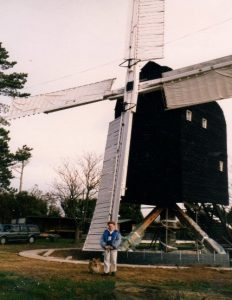 their time. Reader Janet Pelling sent us some pictures of her husband and son, back in the 1980s, helping with the restoration work. On the right you can see son Ian Pelling, aged 11, standing in front of the newly demolished tea-room, before the new roundhouse was built.
their time. Reader Janet Pelling sent us some pictures of her husband and son, back in the 1980s, helping with the restoration work. On the right you can see son Ian Pelling, aged 11, standing in front of the newly demolished tea-room, before the new roundhouse was built.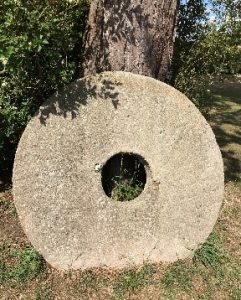 Sheppard also owned Salvington Nurseries just south of Crockhurst Hill and it is possible that he brought the old millstone down the hill – although there are other theories. We think it may have been removed from the mill in the mid-19th century. Although they are very long-lasting, millstones do not last for ever. They are dressed (i.e. the grooves sharpened) regularly but eventually become too thin with the danger of breakage during grinding. The millstone is of Derbyshire Peak stone which produces the rougher, wholemeal flour we produce today on the current stones.
Sheppard also owned Salvington Nurseries just south of Crockhurst Hill and it is possible that he brought the old millstone down the hill – although there are other theories. We think it may have been removed from the mill in the mid-19th century. Although they are very long-lasting, millstones do not last for ever. They are dressed (i.e. the grooves sharpened) regularly but eventually become too thin with the danger of breakage during grinding. The millstone is of Derbyshire Peak stone which produces the rougher, wholemeal flour we produce today on the current stones. The Tailpole and Talthur. The tailpole is the long white beam behind the mill that gives so much fun to visiting children as they move the mill round. The renovation team got the tailpole to the length it should be (as it had been left too short in the 1960s. They also made and installed the talthur, the lever we use to raise the steps, and so release the mill to turn. The image is of a group of visitors enjoying the thrill of moving the mill. Thirty-three tons of mill can be moved by just a couple of people and children enjoy the thrill of such power.
The Tailpole and Talthur. The tailpole is the long white beam behind the mill that gives so much fun to visiting children as they move the mill round. The renovation team got the tailpole to the length it should be (as it had been left too short in the 1960s. They also made and installed the talthur, the lever we use to raise the steps, and so release the mill to turn. The image is of a group of visitors enjoying the thrill of moving the mill. Thirty-three tons of mill can be moved by just a couple of people and children enjoy the thrill of such power.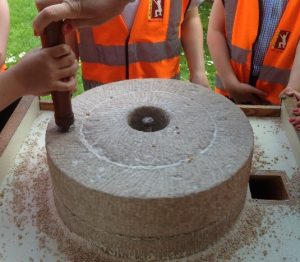 According to myth, it was Ceres who taught humans how to plough, introducing them to grain and the art of grinding. It is believed that grain production began somewhere in or near Mesopotamia and Egypt and could have been growing as early as the 10th century BC. The early grains then crossed with each other to form hybrids, until we eventually ended up with the modern wheat of today.
According to myth, it was Ceres who taught humans how to plough, introducing them to grain and the art of grinding. It is believed that grain production began somewhere in or near Mesopotamia and Egypt and could have been growing as early as the 10th century BC. The early grains then crossed with each other to form hybrids, until we eventually ended up with the modern wheat of today.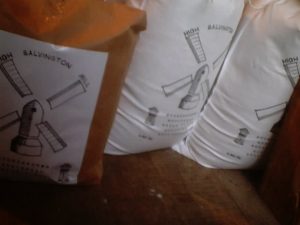 There is a test called the “Hagberg falling number” to measure enzyme activity in flour. It refers to the number of seconds it takes for a plunger to fall through a mix of wheat flour in water. If the plunger falls quickly, it means that the starch has been converted to sugar. However, if the plunger falls slowly, the mixture is thick with starch and thus of good flour. Grain merchants must test their wheat because bakers will only buy flour with a falling number of over 250 (seconds). So millers must ensure that the grain they buy will meet the standard. Ours has to be higher than 250.
There is a test called the “Hagberg falling number” to measure enzyme activity in flour. It refers to the number of seconds it takes for a plunger to fall through a mix of wheat flour in water. If the plunger falls quickly, it means that the starch has been converted to sugar. However, if the plunger falls slowly, the mixture is thick with starch and thus of good flour. Grain merchants must test their wheat because bakers will only buy flour with a falling number of over 250 (seconds). So millers must ensure that the grain they buy will meet the standard. Ours has to be higher than 250.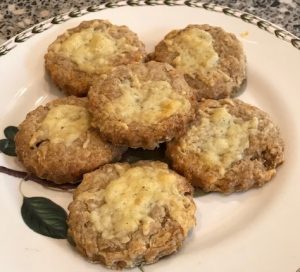 Our flour is produced as souvenir flour. But if you want to bake some souvenir spicy cheese biscuits – here is a recipe. The image is the result of your editor following the instructions. I can report that I put a tad too much cayenne in the mixture for my taste, but they are very cheesy!
Our flour is produced as souvenir flour. But if you want to bake some souvenir spicy cheese biscuits – here is a recipe. The image is the result of your editor following the instructions. I can report that I put a tad too much cayenne in the mixture for my taste, but they are very cheesy! two weeks earlier. He was a man who loved life, especially making happy memories for others. From artist to art teacher, motorcyclist to Morgan connoisseur, Balkan tour operator to travel lecturer/ examiner/author – and Classic Car Day organiser at the windmill – he did everything he could to make the world more fun for others.
two weeks earlier. He was a man who loved life, especially making happy memories for others. From artist to art teacher, motorcyclist to Morgan connoisseur, Balkan tour operator to travel lecturer/ examiner/author – and Classic Car Day organiser at the windmill – he did everything he could to make the world more fun for others.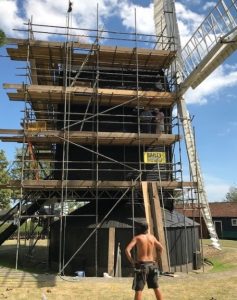

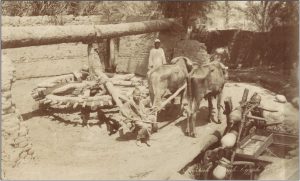
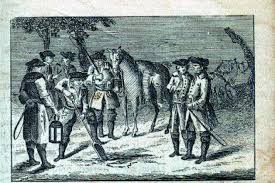

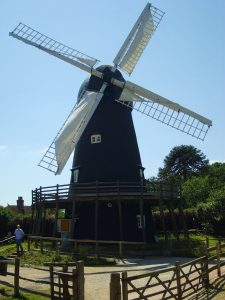
 Toffee fudge cake
Toffee fudge cake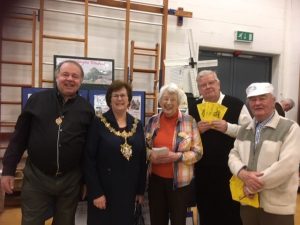 The mill had a stand at the Seed Swap organised by Transition Town Worthing on 8th February. The event was well attended, and the team on our stand handed out leaflets to visitors, including Mayor Hazel Thorpe, while also making some very useful connections for the future. The Seed Swap takes place each year in early February and is a wonderful opportunity to get started in the garden, learn more about recycling, composting, sustainability, health and local food produce.
The mill had a stand at the Seed Swap organised by Transition Town Worthing on 8th February. The event was well attended, and the team on our stand handed out leaflets to visitors, including Mayor Hazel Thorpe, while also making some very useful connections for the future. The Seed Swap takes place each year in early February and is a wonderful opportunity to get started in the garden, learn more about recycling, composting, sustainability, health and local food produce.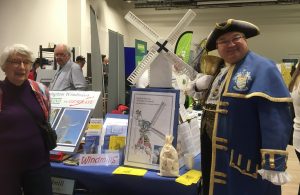 Our brilliant archivist, Wendy Funnell, once again organised a wonderful stand on display at the Rotary Club’s hobbies fair, held this year on 22 February at the Bohunt school. Several of our volunteers manned the stall throughout the day and talked to visitors about the mill, inviting them to come along during the summer months. We also made contact with several groups who would like to organise private tours of the mill outside of our normal opening times. The Town Cryer was in attendance and paid a visit to our stall. The Sompting Morris Dancers were also at the fair – they entertain us all at our annual summer fete. The hobbies fair is organised every two years by the Rotary club. Societies and clubs of all kinds come to show people a huge variety of activities throughout Worthing – anything from ballet to astronomy, stamp collecting to – well – windmills.
Our brilliant archivist, Wendy Funnell, once again organised a wonderful stand on display at the Rotary Club’s hobbies fair, held this year on 22 February at the Bohunt school. Several of our volunteers manned the stall throughout the day and talked to visitors about the mill, inviting them to come along during the summer months. We also made contact with several groups who would like to organise private tours of the mill outside of our normal opening times. The Town Cryer was in attendance and paid a visit to our stall. The Sompting Morris Dancers were also at the fair – they entertain us all at our annual summer fete. The hobbies fair is organised every two years by the Rotary club. Societies and clubs of all kinds come to show people a huge variety of activities throughout Worthing – anything from ballet to astronomy, stamp collecting to – well – windmills. The mill sails were placed in the mourning position recently when we heard of the death of John Simmonds. Peter Casebow remembers him.
The mill sails were placed in the mourning position recently when we heard of the death of John Simmonds. Peter Casebow remembers him.


 The fete raised over £3000 – every penny of which goes towards the upkeep of the windmill.
The fete raised over £3000 – every penny of which goes towards the upkeep of the windmill. Channel 4’s “A Place in the Sun – Home or Away” chose our windmill to help property hunters Emma and Gracie Lofthouse to find the home they’ve always wanted by looking in the UK and abroad. Producer/Director Ruth Wilson, the sound engineer, and presenter Laura Hamilton filmed several sequences outside our windmill and mentioned some of the history behind it. Roz, Mel and Lucy let them in and gave them the information they needed to do the piece. The show will be aired within the next six months on Channel 4 so look out for it.
Channel 4’s “A Place in the Sun – Home or Away” chose our windmill to help property hunters Emma and Gracie Lofthouse to find the home they’ve always wanted by looking in the UK and abroad. Producer/Director Ruth Wilson, the sound engineer, and presenter Laura Hamilton filmed several sequences outside our windmill and mentioned some of the history behind it. Roz, Mel and Lucy let them in and gave them the information they needed to do the piece. The show will be aired within the next six months on Channel 4 so look out for it. prior to their departure to take part in Dance World Cup. This is the biggest dance competition in the world. Over 20,000 competitors from 62 countries competing at their country qualifiers and at the World Finals each year. Seven girls (age 12-17) from Nicola Miles Theatre Studios (in Worthing) competed for Team England (one of two dance schools in England in this category) in the junior small groups section on Saturday 6th July. They danced a Turkish National Dance and came eighth in the whole world. Well done.
prior to their departure to take part in Dance World Cup. This is the biggest dance competition in the world. Over 20,000 competitors from 62 countries competing at their country qualifiers and at the World Finals each year. Seven girls (age 12-17) from Nicola Miles Theatre Studios (in Worthing) competed for Team England (one of two dance schools in England in this category) in the junior small groups section on Saturday 6th July. They danced a Turkish National Dance and came eighth in the whole world. Well done. On Saturday 22nd of June, local members from the Institute of Mechanical Engineers (pictured) plus some guests enjoyed a fabulous tour of the Windmill. The sun was shining which made for some great photo opportunities before and after the tour. Organiser Charlie Allen said: “We were guided by two exceptionally experienced guides who had extensive knowledge of the mill and its restoration. Following the tour and many questions from our members, we enjoyed some beautiful homemade cake and a cup of tea in the sunshine. Thank you to all of the volunteers that made our visit so interesting and welcoming, and for the great conversations we all were part of.”
On Saturday 22nd of June, local members from the Institute of Mechanical Engineers (pictured) plus some guests enjoyed a fabulous tour of the Windmill. The sun was shining which made for some great photo opportunities before and after the tour. Organiser Charlie Allen said: “We were guided by two exceptionally experienced guides who had extensive knowledge of the mill and its restoration. Following the tour and many questions from our members, we enjoyed some beautiful homemade cake and a cup of tea in the sunshine. Thank you to all of the volunteers that made our visit so interesting and welcoming, and for the great conversations we all were part of.” The craft fair this year was a great success with 25 stalls selling all manner of stitched, painted, carved, and woven items. The weather was kind and the stallholders reported very high interest in their craftwork. Visitor numbers were high, and besides the stalls, entertainment was provided by the Sompting Morris Dancers.
The craft fair this year was a great success with 25 stalls selling all manner of stitched, painted, carved, and woven items. The weather was kind and the stallholders reported very high interest in their craftwork. Visitor numbers were high, and besides the stalls, entertainment was provided by the Sompting Morris Dancers.